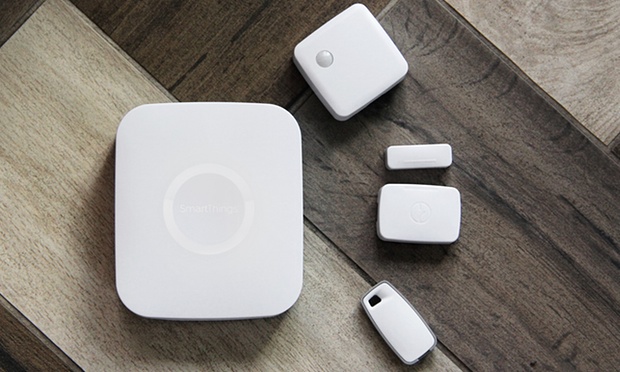Samsung is trying to bring order to the untamed wilds of the Internet of Things with its newly announced SmartThings Hub. The Hub comes armed with a pack of sensors that might finally give household devices the chance to have meaningful conversations that benefit their owners.
This follows Samsung’s acquisition of SmartThings last year, and it’s a bold move that will find direct competition from Apple, which announced its Home app and HomeKit last year, and Google, with an Android platform set to capitalize on their Nest products.

Samsung SmartThings Hub
As The Guardian reports, Samsung is promising banking-level security for the communication web that Hub forges between devices. The electronics behemoth is also claiming interest in keeping their IoT open and compatible with many devices (SmartThings-branded devices as well as other products from Samsung and accessories from Bose, Philips, Honeywell, Yale, LIFX, Aeon, and others). This last bit is of special interest to experience designers, as the industry has long been aware of the need to get devices sharing information across platforms in ways that are meaningful to users.
It’s way more about the service and the experience than it is about the gadgets, something Claire Rowland stresses in her book, Designing Connected Products:
When we talk about IoT, we tend to focus on the devices, particularly those with striking or novel forms. But the behavior of the device might be generated by a program that lives on another device on the network … This means that the service around a connected device is often just as critical in delivering the user experience, if not more so, than the device itself. For example, the smart travelcards such as the London Oyster and Hong Kong Octopus are often thought of as the focus of the payment service. But the services can be used without a card at all via an NFC-enabled smartphone or bank card. The card is just an “avatar” for the service.
In the next five years, we can expect that all new Samsung devices—from fridges to televisions to washing machineswill be SmartThings Hub-ready. By that time, it feels safe to assume that Google and Apple will also be flush with IoT products and services. If there’s any sanity left in the world, all of these devices and systems will have some way of singing in chorus.
So while the SmartThings Hub has markings of the bridge that ubiquitous computing has been waiting for, the release also has the bad fortune of coinciding with toymaker Sphero unleashing teaser video of its version of the BB-8 droid from the forthcoming Star Wars: The Force Awakens.
This Bluetooth connected device has all kinds of appeal: you get to drive it around with an app, it’s small enough to keep in your backpack, and it zips around in the same astonishing way that it’s cinematic counterpart does in the movie trailer.
Unsurprisingly, there seems to be a lot more Twitter fanfare around #BB8 than #SmartThings at the moment, and that’s not a huge surprise. Until that day when the fridge can actually sense that you’re low on unsweetened organic coconut milk and order you more, the Internet of Things will remain an abstraction to most people.
App-controlled Star Wars droids that float like magic? That’s for real.







